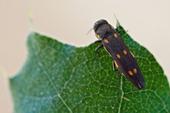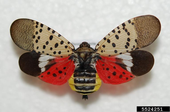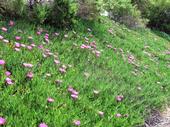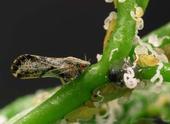
There are several flatheaded boring beetles in California, however only a few are of particular concern. The goldspotted oak borer (GSOB), Agrilus auroguttatus, is a metallic wood-boring beetle that threatens our native trees. Since it was introduced to Southern California on contaminated firewood in the early 2000s, this pest has caused extensive damage to woodlands and native oaks.
What does the goldspotted oak borer look like?
Adult GSOB are 0.4 inch long and 0.08 inch wide with bullet-shaped bodies. They are black with an iridescent green sheen and six distinct gold spots on their back.
What damage does the goldspotted oak borer cause?
Goldspotted...

The Spotted Lanternfly (SLF) is an invasive pest that poses a great threat to California's agriculture. It was first discovered in the U.S. in Pennsylvania in 2014, and has since taken the east coast by storm, causing damage to many plant species and proving to be difficult to control. Although this pest hasn't been found in California, it is important to keep an eye out to catch an invasion early.
What does the spotted lanternfly look like?
The SLF adult is about 1 inch in length with grayish wings, black spots, and red hind wings. Egg masses are laid in the fall on the east coast and resemble splotches of mud. They are often laid on smooth surfaces like branches, rocks, or outdoor furniture....

You've probably seen this invasive plant growing along highways or the coast in California. Highway iceplant, Carpobrotus edulis, was intentionally introduced to prevent soil erosion along highways and coasts but it has since invaded many different ecosystems and outcompetes native plant species. The California Invasive Plant Council (Cal-IPC) rated this plant as an A-1 species, meaning it is one of the “most invasive and damaging species that are widespread in the state.”
What does highway iceplant look like?
The highway iceplant, also known as the hottentot fig, is a succulent with fleshy three-sided stems. It grows as dense...

The Asian Citrus Psyllid (ACP) is a small, aphid-sized insect that poses a serious threat to California's citrus trees. This invasive pest can carry and transmit a fatal bacterial disease called Huanglongbing (HLB) to all citrus species. HLB has already decimated citrus groves throughout Florida, costing the citrus industry millions of dollars. The psyllid is currently present in Southern California, but preventative measures can keep the disease and insect from spreading to California's citrus growing regions.
What does the Asian citrus psyllid look like?
Asian citrus psyllid adults are 1/6 to 1/8 inch long with brown wings and red eyes. They feed on plants at a 45-degree angle, with their...

The 10th annual California Invasive Species Action Week (CISAW) will kick off Saturday June 3rd and runs to Sunday June 11th. This week is designed to raise awareness and encourage public participation in the ongoing fight against invasive species. These invaders are non-native plants, animals, or pathogens that can negatively impact our waters, native ecosystems, agriculture, health, and economy. Every day this week we will be spotlighting a different invasive species and its impacts.
You can participate during Action Week and all year long by doing the following:
- Check out UC IPM's previous blog posts on


